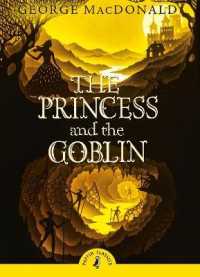基本説明
Designed for use as a companion to Introducing Language in Use, but also highly usable as a stand-alone text, this reader includes: 29 seminal papers from authors including Sarah Mills, David Crystal, Norman Fairclough and many others.
Full Description
Designed for introductory students, this collection of key readings in language and linguistics will take readers beyond their introductory textbook and introduce them to the thoughts and writings of many esteemed authorities. The reader includes seminal papers, new or controversial pieces to stimulate discussion and reports on applied work.
Language in Use:
is split into four parts - 'Language and Interaction', 'Language Systems', 'Language and Society' and 'Language and Mind'
covers all the topics of language study including conversation analysis, pragmatics, power and politeness, semantics, grammar, phonetics, multilingualism, child language acquisition and psycholinguistics
has readings from authorities including Pinker, Fairclough, Crystal, Le Page and Tabouret-Keller, Hughes, Trudgill and Watt, Halliday, Sacks, Mills, Obler and Gjerlow
provides comprehensive editorial support for each reading with introductions, activities or discussion points to follow and further reading
Is supported by a companion website, offering extra resources for students including additional activities, useful weblinks and advice from the authors
Designed for use as a companion to Introducing Language in Use (Routledge, 2005), but also highly usable as a stand-alone text, this Reader will introduce readers to the wide world of linguistics and applied linguistics.
Contents
Part 1: Language and Interaction Introduction 1.1 Harvey Sacks On the Preferences for Agreement and Contiguity in Sequences in Conversation 1.2 Bethan Davies Grice's Cooperative Principle: Meaning and Rationality 1.3 Rebecca Barry and Andrew Merrison Language-in-Use: a Clarkian Perspective 1.4 Ronald R. Butters How Not to Strike it Rich: Semantics, pragmatics, and Semiotics of a Massachusetts Lottery Game Card 1.5 Sara Mills Impoliteness 1.6 Karen Grainger Reality Orientation in Institutions for the Elderly: The Perspective from Interactional Sociolinguistics 1.7 Bethan Benwell and Elizabeth H. Stokoe University Students Resisting Academic Identity Part 2: Language Systems Introduction 2.1 Ingo Plag Productivity and the Mental Lexicon 2.2 Arthur Hughes, Peter Trudgill and Dominic Watt Regional Accent Variation 2.3 Michael Halliday Language in a Social Perspective 2.4. Rachel Sutton-Spence and Bencie Woll Constructing Sign Sentences 2.5 James Milroy Giving a History to English 2.6 Andrew Goatly Metaphor and Relevance 2.7 Jill and Charles Hadfield with Anthea Gupta Travels with Auntie Part 3: Language and Society Introduction 3.1 Robert B. Le Page and Andree Tabouret-Keller Acs of Identity 3.2 Ellen Bialystok Bilingualism at School: Effect on the Acqusition of Literacy 3.3 David Crystal An English Family of Languages 3.4 Sue Wright Language Education and Foreign Relations in Vietnam 3.5 Graham Turner Why Protect Heritage Sign Languages? 3.6 Norman Fairclough Language and Discourse 3.7 Tony McEnery How British Men and Women Swear Part 4: Language and Mind Introduction 4.1 Loraine Obler and Kris Gjerlow How we Know what we Know about Brain Organization for Language 4.2 Charles Goodwin, Marjorie H. Goodwin and David Olsher Producing Sense with Nonsense Syllables: Turn and Sequence in Conversations with a Man with Severe Aphasia 4.3 Steven Pinker Language Acquisition: how do they do it? 4.4 Michael Jeffrey Farrar Negative Evidence and Grammatical Morpheme Acquisition 4.5 Holger Diessel Learning versus Growth 4.6 Todd R. Haskell, Maryellen C. Macdonald and Mark S. Seidenberg Language Learning and Innateness: Some Implications of Compounds Research 4.7 Gunther Kress and Theo van Leeuwen The Semiotic Lanscape 4.8 Michael E. R. Nicholls, Dara A. Searle and John L. Bradshaw Read My Lips: Asymmetries in the Visual Expression and Perception of Speech Revealed through the McGurk Effect








